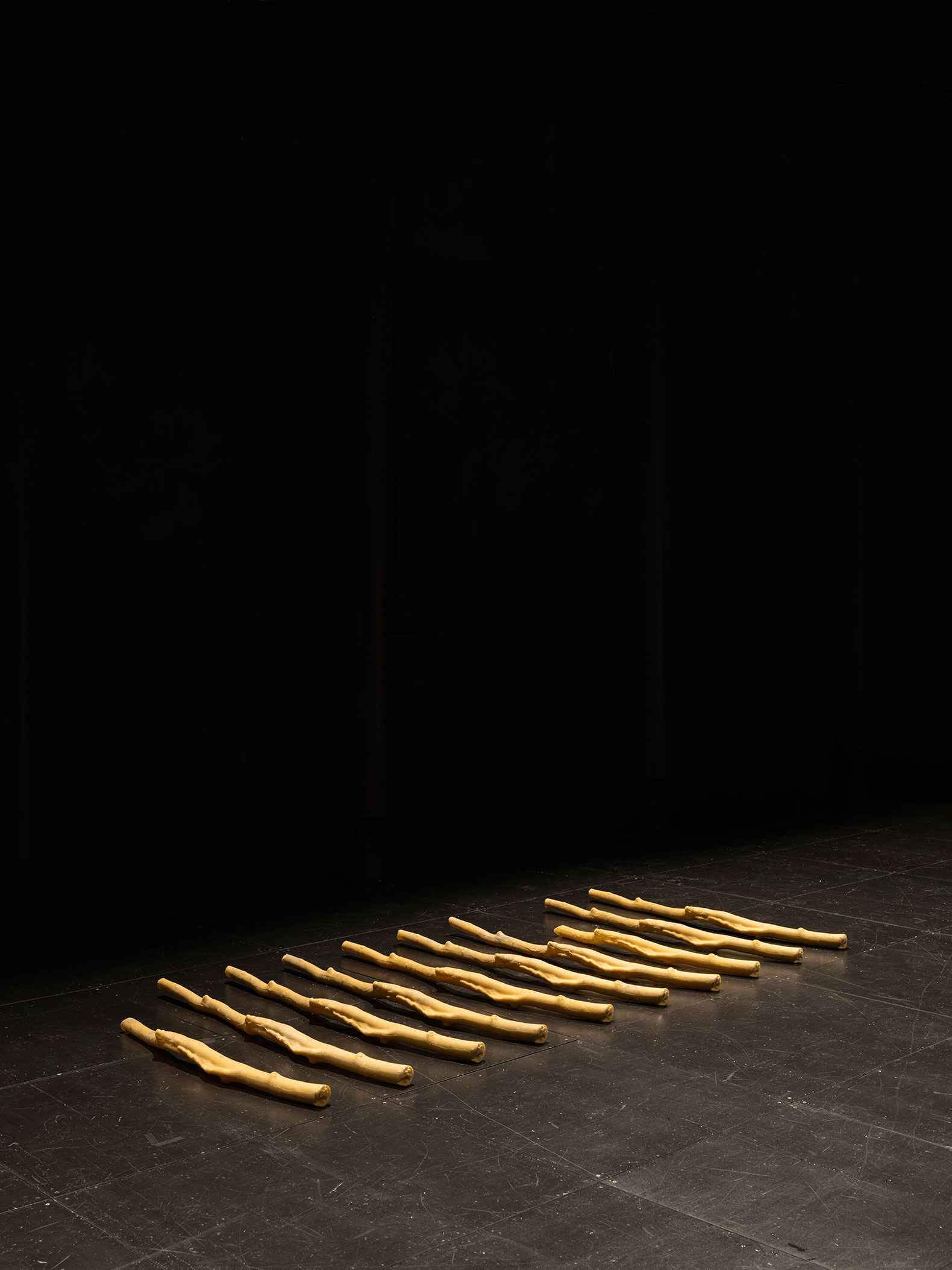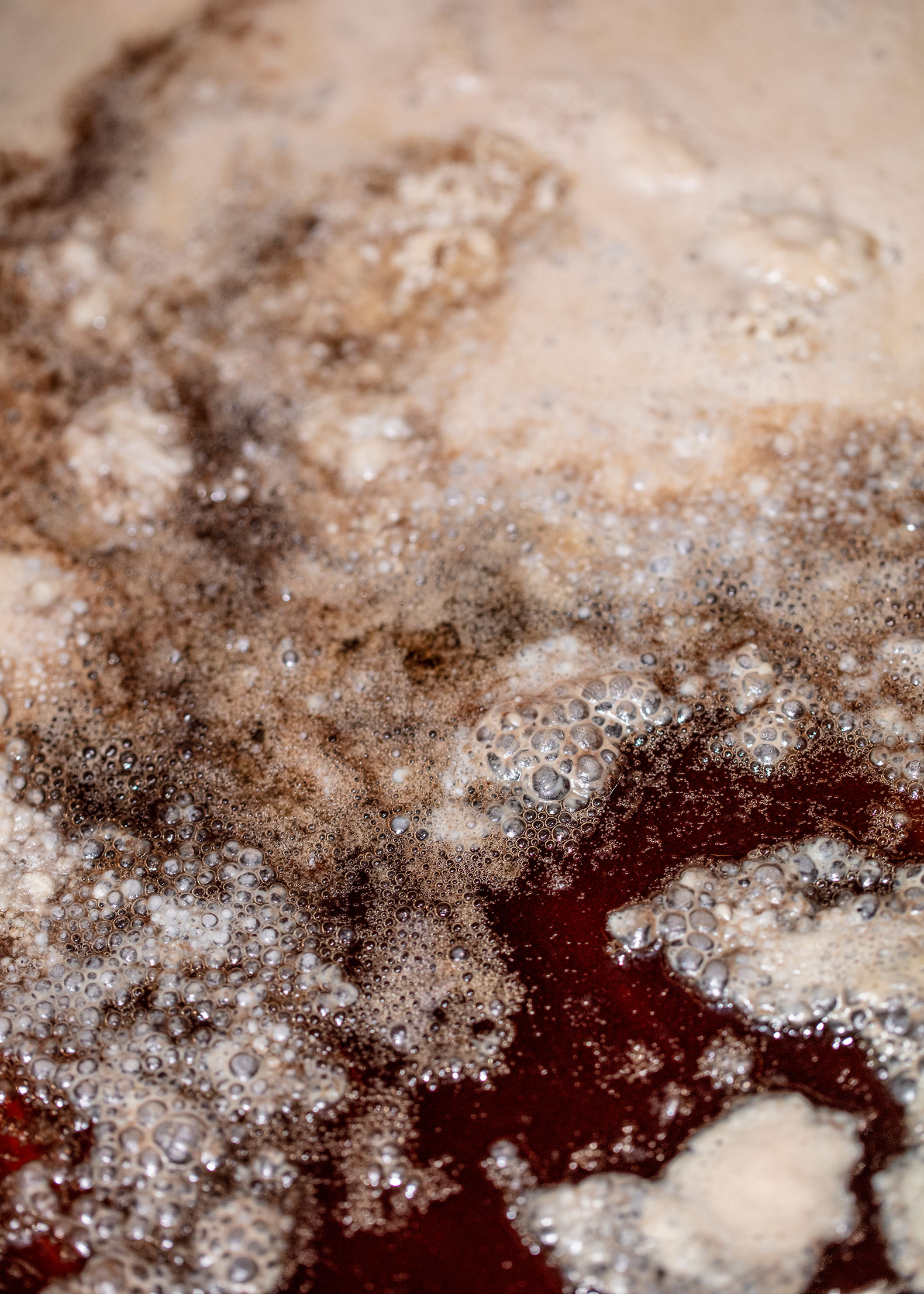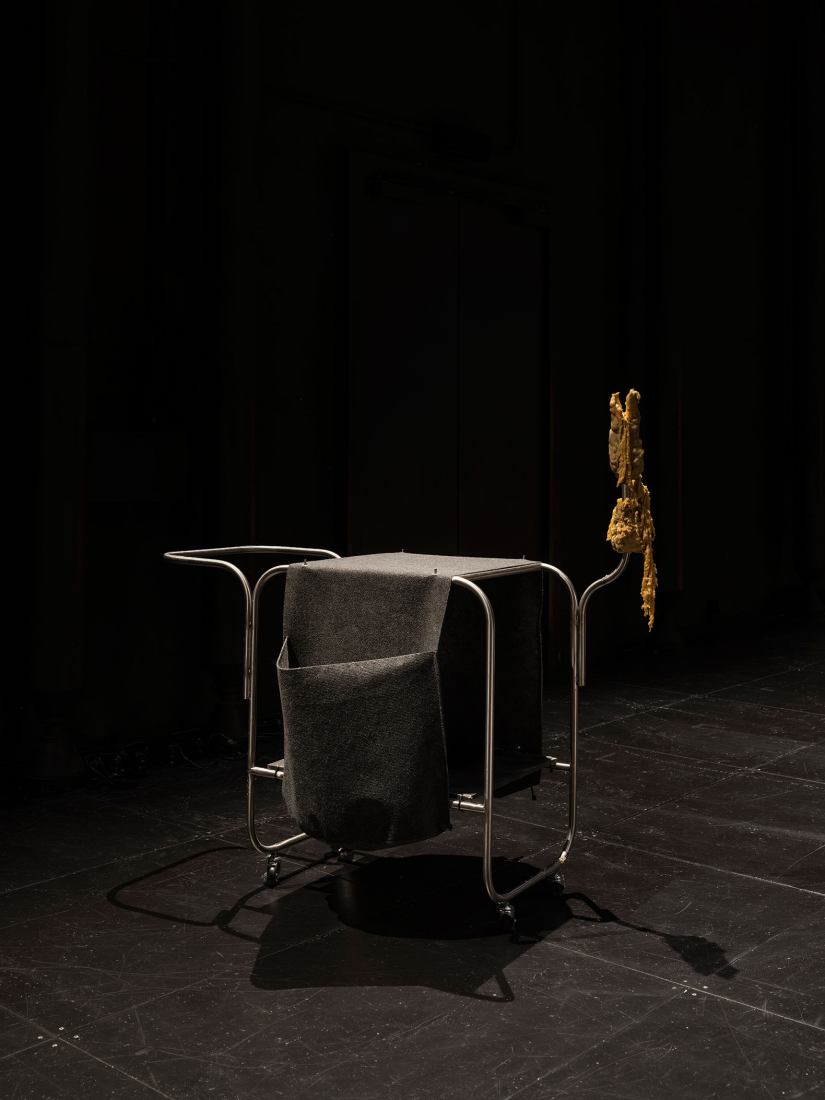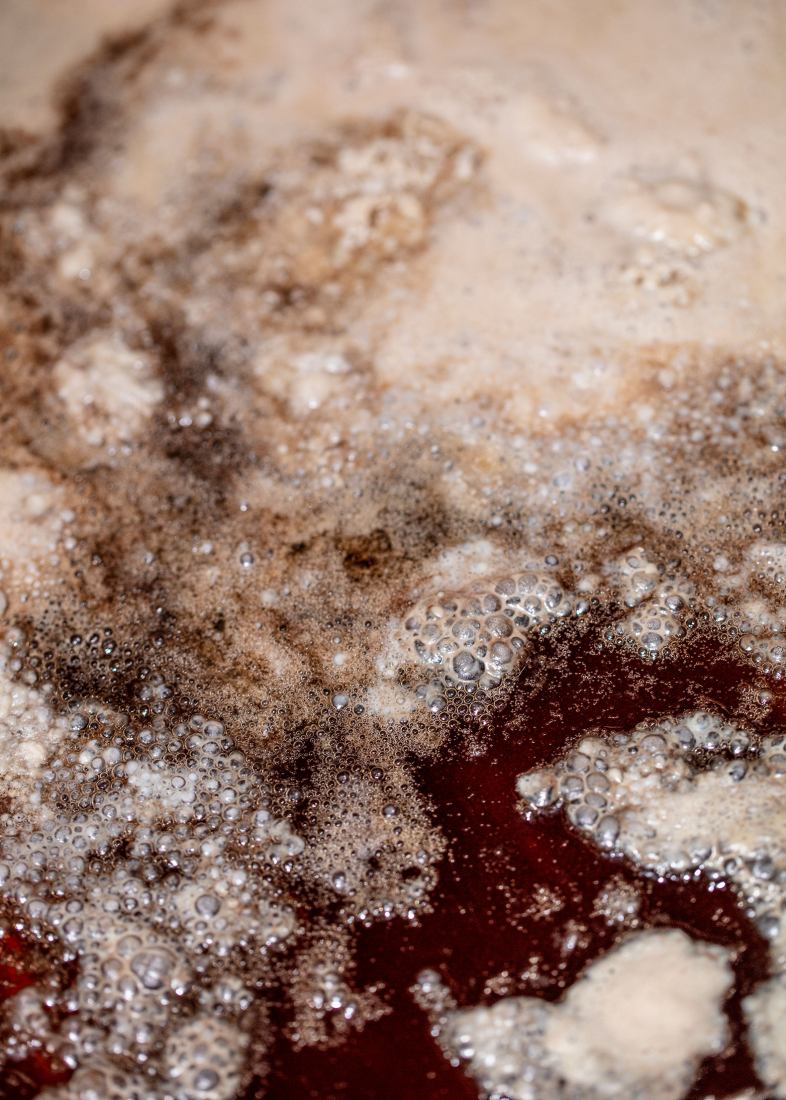"Ruines" as an ensemble seems to instrumentalize actions where form keeps fading away to release times and speeds; dimensions of multiplicities, extensive and intensive. Repetitions and differences.
"In order not to play the game of the guardians of representation, it would be imperative that the very game of difference flees without methodological prescriptions: in the real experience of encounters, as problematic correspondences of heterogeneities that scourge thinking and feeling."
“The Philosophy of Deleuze” – Dossier Número especial #1 – Deleuze – Revista Reflexiones Marginales – July 2016.

"Ruines" by Giona Bierens De Haan. Photograph by Dylan Perrenoud.
[I]
The tower rises into the scene. Erected in its contradiction or tension, in its phallic totemic positioning. However, with its flexible constitution, light and ephemeral, it is felt and perceived as precarious and transitory, like the rest of the constructions and artifacts of the installation.
Tower that disengages itself from its rigid and vertical appearance, to culminate in a big basin. Recipient pot that hosts the substance to generate an encounter that mutates and modifies it. To become-other. Where chance, should there be such a thing, produces a diversity of forms that resist being understood as such. Stalactites, organic fragments, or industrial plastic waste.
Potential remains and sign gestures.
In its quasi-alchemical passages, wax oozes and drops. The container with liquid receives a fluid substance which, on contact, solidifies without previous plan or organization, where diverse singular and particular conditions of that mutual and chaotical encounter are articulated. From which both will come out modified. The fluid remnant will be consolidated into signs and fragments of other territories, which will in turn present themselves as transitory and consumable. Vehicles and objects mediate an unresolved ritual articulation.

"Ruines" by Giona Bierens De Haan. Photograph by Dylan Perrenoud.
[II]
A foundry platform offers another assembly line from unique and ephemeral molds. Thus, being singular, it is an operation whose result we know or perceive. This device instrumentalizes another concept. It pours the wax fluid on molds that pre-establish the form-sign to produce and reproduce. In these, beyond the resonance with the organic vegetable elements they shape, the operation poses an eerie tension between their similarities and divergences. Objects replicas that, in their multiplication specific to each mold, probably allow us to detect, incorporate, and problematize the differences in related or similar operations, in analogy to other fields.
Strange gadgets, mechanical devices, sign-producing artifacts and machines, producers of mediatory objects.

"Ruines" by Giona Bierens De Haan. Photograph by Dylan Perrenoud.
[III]
The ensemble seems to offer us and introduce us to an experience related to rhizomatic perceptions and conceptualizations on its potential meaning and functioning. Which ruins does it refer to, on the ruins of which territory, structure, or system does it propose this delocalization and reterritorialization, in an atmosphere that appeals to us from the senses.
The ambiguous display of a presumed dichotomy between the seemingly “natural” or organic and the artificial-industrial can deceive or at least confuse us. Things are not what we see. Our perceptions and experiences exceed them, exceed us.
Elementary machineries, from the imagination of the beginnings of the Industrial Revolution, replicate in different ways the alchemic and constantly mutable operations of the organic universe, that enable and inhabit an endless capacity for the production of differences, unpredictable shapings, mixtures, and transformations.
Technical-analog systems cook and cast the thing-material-like resonances of ancestral collective memory. The memory of the both mythical and ritual relationship we have with elements and with the bonds through which we organize imaginary universes through their signifiers.

"Ruines" by Giona Bierens De Haan. Photograph by Dylan Perrenoud.
There seems to be a hinted trajectory, not imposed, through an assembly line that evokes Fordism; production of a certain something that upholds the enigma in its “utility”, purpose, or use. But this trajectory makes one wonder whether it is made to guide, to escort the gaze through diverse processes of transformation of forms and matter, or whether it is there to encourage extensive and intensive experimentation of the transformation, the mutability in our bodies, in our singular, alternative, perceptual and conceptual subjective production.
The objects, the signs, and the ritual of and on inadequacy. The inadequacy of things and their functioning. Their inadequacy to our perceptions and potential constructions of meaning dissident to the imposed planning and subjectivation. Rehearsals on a language of inadequacy as a tool for displacement and dislocation.
The potential ritual, ignoring the myth. We will have to invent, every time, specific protocols.

"Ruines" by Giona Bierens De Haan. Photograph by Dylan Perrenoud.
It may be not only the machines’ divergent operating modes and their resulting objects that present certain presumed antagonisms but also the coexistence of cold artificial lighting and the warmth of candlelight, like the unresolved relationship among the arrangement of the elements whose presented bonds remain mysterious and unknown.
As a whole, they contribute to an estranged general atmosphere, of counterpoints and open ambiguities that leave it up to us to predict, guess or invent what all this might be about. It is in this non-specific contingency that we are encouraged to produce a situated experience, an encounter in unhinged time and coordinates.
There is a hovering idea of a system, where the elements do not determine their interconnections or interdependencies within the overall complexity.
It could also be referenced to a body with parts operating in disjointed ways with no pre-established overall organization, to which we will need to continuously offer an operating test stemming from our projections and drives.
In the face of the disjoint performance of its parts, it seems that we will have to intervene; our actions and our imaginaries will contingently assemble a potential plane of immanence of the ensemble, that will alter it and momentarily organize it, putting it or us at a certain risk of stability or instability.

“Ruines” by Giona Bierens De Haan. Photograph by Dylan Perrenoud.
[IV]
A brief inventory of the rest:
- Transportation and transformation of materials and the states of matter as an analogy of the required mobility and mutability of every vital and throbbing process.
- Two provisional lairs, potential fortresses where we can for a moment entrench ourselves and look out from that fleeting containment at the surrounding tension. Also, shelters, as though entities, with eyes that stare and invite us to dig into it.
- A group of fake monoliths of encrypted, not explicit meaning and participation; in the ensemble, they are camouflaged as seats.
- Twelve hollow branches of wax made by casting, stand as silent witnesses of the artificial organic and of the repetition and difference.
- A simulation of the sun in LEDs.
- A round hearth space, as though a ceremonial center awaiting the invention of some ritual.
- A cart to shift objects into another physical and metaphysical plane.
- Two provisional lairs, potential fortresses where we can for a moment entrench ourselves and look out from that fleeting containment at the surrounding tension. Also, shelters, as though entities, with eyes that stare and invite us to dig into it.
- A group of fake monoliths of encrypted, not explicit meaning and participation; in the ensemble, they are camouflaged as seats.
- Twelve hollow branches of wax made by casting, stand as silent witnesses of the artificial organic and of the repetition and difference.
- A simulation of the sun in LEDs.
- A round hearth space, as though a ceremonial center awaiting the invention of some ritual.
- A cart to shift objects into another physical and metaphysical plane.
[V]
How to deal with the need and urge to plan? How to overcome anticipation and incorporate unpredictability? Giona Bierens de Haan asks himself and us.
Perhaps exaggerating those stages. Over-planning instances, draw us closer to excesses. Or delving into absurd, incomprehensible operating codes. Rehearsals on infeasibility within the same project and its plan.

"Ruines" by Giona Bierens De Haan. Photograph by Dylan Perrenoud.
Planning is also altered through parasitic actions on the pre-established, and the order command is transferred to political levels. A critique on mass production of a lab-made subjectivity begins.
For the myth of a homogeneous and obedient community even has a ritual character, nurtured by a self-repressive ethic, to guarantee the maintenance of the purified community.”
Sennet, Richard (1970). The Uses of Disorder. Personal Identity and City Life. New York: Knopf.
“If Fordist capitalism strangled individual subjectivity by canceling desire and a vital impulse to guarantee a closed community, late capitalism acts with renewed mechanisms, but with the same aspiration. Now, the government of subjectivity is no longer resolved only by denying its public relevance, but by using a dominated public sphere as a showcase - window or screen - for the patterns of subjectivity that are to animate the market.”
Peran, Martí (2008). Post-It-City.Occasional Urbanities. (Catalogue of exhibition Post it City).

"Ruines" by Giona Bierens De Haan. Photograph by Dylan Perrenoud.
[VI]
The installation, like a timeless space inhabited by a hand-operated, analogic technology -eccentric machinery-, exhibits the exacerbation of the presumed systemic functioning of things.
These machines will likely expose the fragmented sense, the unconnected sense.
The ensemble, instead of forcing or resolving the direction of their interconnections, will likely explore variables or flights, incorporating other ways, unthought-of in its planning, that attempt to crack the modern utopian imaginary of resolution and functioning.
Because the proposal combines this mechanical, automaton-like maneuvering with the multiplicity and unpredictability of actions and connections of perception and meaning that we humans can project according to each contingency, to the perceptual, affective, and emotional variables that will in turn generate diverse drifts and provisional made-up trajectories and meanings.

"Ruines" by Giona Bierens De Haan. Photograph by Dylan Perrenoud.
Which will in turn produce random, accidental encounters where an anomaly, an extreme complexity, or a strange drift could occur. Alterity of relationship that can weave unforeseen alliances and/or produce cracks or strains in the presumed system performance.
The proposal delves both into the certainty and the improbability of the functioning and meaning of the machinery, and it does so as a resource and power of questioning. It explores the “nature” and dynamics of certain object articulations, manufacturing entities, users, and interactors of these rituals in a critical process, of expansion and deconstruction of the imaginary. Of many, of the neo-positivist, productivist, and consumerist imaginary, among others.
It reveals the machines, devices, objects, and organizations that we deploy as we engage with the world. It displays and strains different ways of binding us with each other, from conquering, and colonizing positions and actions to those of mutually modifying coexistence, closer to world-becoming.
And in those tensions, the installation, the atmosphere, and these devices in their strange bond could be capable of contradicting, of short-circuiting the system’s apparatus, the apparatus of Power, which somehow still demands centralism, order, and territorialization.

"Ruines" by Giona Bierens De Haan. Photograph by Dylan Perrenoud.
A machine of the productive and reproductive apparatus is confined and/or reduced to its functional action and its result. With these doubt-machines, of deviated and simultaneous meanings, "Ruines" would not attempt to take control over its spectators or interactors. It probably offers or provides resources that seek to boost thought, perception, and imagination. To "hack", to put into a trance, or to interrupt the circuits of modern and contemporary common sense. To probe and to project ways of alternative functioning, which in turn imply or underline the harmfulness of the current paradigm of production, reproduction, and existence.
Amid the factory space of workers and labor an air of shamanism and anthroposophy also hovers, in a nod to Joseph Beuys and the neo-Dadá Fluxus movement.
Beyond this, I am interested in connecting with the plane of philosophy of difference and experience. The production of experience in and of the complexity of encounters. Like a differential, gear capable of bringing heterogeneous elements together, the strange crease where what is gathered experiments the odd bond as something that plunges them into a time outside of themselves.
Something "Deleuzian", indeed, like the proposition of conceptual encounters. Where we could experiment with the concept “like the object of an encounter, like the here-now”.

"Ruines" by Giona Bierens De Haan. Photograph by Dylan Perrenoud.
In two of all the potential and varied order of dimensions: 1 - that in which the entities live the experience according to their respective constitutive composition relationships -or not- in movement or rest or speed or slowness; 2 - that in which, in its mutual relationships, they live the experience of increase or decrease of their “power to exist” and their “capacity to be affected”; the experience of what happens, therefore, in their “intensive states”, experiences that hurl them into passions, those signs that life apprehends in its encounters.
"The Philosophy of Deleuze" – Dossier Número especial #1 – Deleuze – Revista Reflexiones Marginales – July 2016 - On Gilles Deleuze, “Spinoza et nous” - 1981.
When confronted with the chaos of encounters, we would attempt to trace a “plane of immanence” that would foster the production of displaced knowledge constructed by poetic sensibilities.
This would imply ways of invention sensitive to the problematic character of encounters.
This problematic character is in an immanent relationship with the circumstantiality and contingency of the encounters, which weaves us to experience, to the body, to that which ignites its articulation of forces, to what absorbs us in its tension, and enables multiple flights.
Maybe mere multiplicity is not enough to rip the fabric of meaning and of the established senses, but we are invited and summoned to feel and think about the differences.

"Ruines" by Giona Bierens De Haan. Photograph by Dylan Perrenoud.
Like extensive and intensive encounters on the organization of things and relationships, that bring into play another experience of exercising the faculties of feeling, remembering, imagining, thinking, interacting, and inventing.
They suggest that the fundamental issue would be more in the tensions, in the “forces, in the densities and intensities” and not “in the forms and materials” - also Deleuze -.
The proposed precariousness and transience, like the enigma of relationship that puts on hold the actions and rituals that we will need and will unfold each time, would be on the side of potency. Not Power. They would be fostering or generating non-specific conditions for the possibility of potency. Poetic potencies to exercise affective imagination of meaning, of perception, of community micro-politics.







































